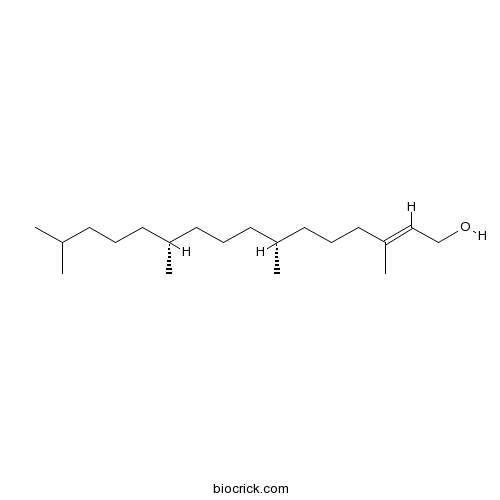Ardisia brevicaulis
Ardisia brevicaulis
1. The products in our compound library are selected from thousands of unique natural products; 2. It has the characteristics of diverse structure, diverse sources and wide coverage of activities; 3. Provide information on the activity of products from major journals, patents and research reports around the world, providing theoretical direction and research basis for further research and screening; 4. Free combination according to the type, source, target and disease of natural product; 5. The compound powder is placed in a covered tube and then discharged into a 10 x 10 cryostat; 6. Transport in ice pack or dry ice pack. Please store it at -20 °C as soon as possible after receiving the product, and use it as soon as possible after opening.
Natural products/compounds from Ardisia brevicaulis
- Cat.No. Product Name CAS Number COA
-
BCN1673
Phytol150-86-7
Instructions

Ardisiphenol D, a resorcinol derivative identified from Ardisia brevicaulis, exerts antitumor effect through inducing apoptosis in human non-small-cell lung cancer A549 cells.[Pubmed: 24392814]
The in vitro and in vivo antitumor activities of ardisiphenol D, a natural product isolated from the roots of Ardisa brevicaulis Diels (Myrsinaceae), have been studied.
Alkylphenols from the roots of Ardisia brevicaulis induce G1 arrest and apoptosis through endoplasmic reticulum stress pathway in human non-small-cell lung cancer cells.[Pubmed: 22863707]
From the roots of Ardisia brevicaulis DIELS, two new alkylphenol derivatives, named ardisiphenol E (2) and F (3), have been isolated together with a known alkylphenol, ardisiphenol D (1). The structures of 1-3 were elucidated by chemical and spectroscopic techniques. Compounds 1 and 2 exhibited strong cytotoxicities on two human non-small-cell lung cancer cell lines (H1299 and A549). We found that compounds 1 and 2 upregulated mRNA and protein expressions of endoplasmic reticulum (ER) stress markers including C/EBP homologous protein (CHOP), binding immunoglobulin protein (Bip) and inositol-requiring enzyme 1 (IRE1) indicating 1 and 2 are novel natural ER stress inducers. Treatments with 1 and 5 µM of 1 or 2 triggered G1 arrest in H1299 and A549 cells with concomitant downregulation of ubiquitin fusion degradation protein 1 (Ufd1) and S-phase kinase-associated protein 2 (Skp2) proteins and the accumulation of p27, the key axes of ER stress-mediated G1 arrest. Compounds 1 and 2 also induced apoptosis at high concentrations (10, 20 µM) which was shown to be coupled with the upregulation of CHOP and Bim, the activation of caspase-9, caspase-3 and poly(ADP-ribose) polymerase (PARP) cleavage. These results indicate that compounds 1 and 2 induce ER stress that subsequently causes G1 arrest and apoptosis in human non-small-cell lung cancer cells and they may have potential anticancer effects.
Antitumor effect of resorcinol derivatives from the roots of Ardisia brevicaulis by inducing apoptosis.[Pubmed: 21751842]
Two new resorcinol derivatives 2-methoxy-4-hydroxy-6-(8Z-pentadecenyl)-benzene-1-O-acetate (1) and 2-methoxy-4-hydroxy-6-pentadecyl-benzene-1-O-acetate (2), together with four known compounds 2-methoxy-4-hydroxy-6-tridecyl-benzene-1-O-acetate (ardisiphenol D, 3), 5-(8Z-pentadecenyl)resorcinol (4), 5-pentadecylresorcinol (5), 5-tridecylresorcinol (6), have been isolated from the roots of Ardisia brevicaulis in our previous work. In the present study, the inhibitory effect of 1-6 on the proliferation of human pancreatic PANC-1, human lung A549, human gastrointestinal carcinoma SGC 7901, human breast MCF-7, and human prostate PC-3 cancer cells was evaluated by the methyl thiazolyl tetrazolium method. Compounds 1-6 all showed inhibitory activities against the proliferation of PANC-1, A549, SGC7901, MCF-7, and PC-3 cancer cells. Compound 3, the most active agent and the main constituent with the highest yield, induced apoptosis of PANC-1 cells (the most sensitive cell line among the cell lines screened) via the activation of caspase-3 and caspase-9, up-regulation of the ratio of bax/bcl-2 protein expression.
Two new resorcinol derivatives with strong cytotoxicity from the roots of Ardisia brevicaulis Diels.[Pubmed: 21162003]
Two new resorcinol derivatives, 4-hydroxy-2-methoxy-6-[(8Z)-pentadec-8-en-1-yl]phenyl acetate (1) and 4-hydroxy-2-methoxy-6-pentadecylphenyl acetate (2), together with known compounds ardisiphenol D (3), 5-tridecylresorcinol (4), 5-pentadecylresorcinol (5), 5-[(8Z)-pentadec-8-en-1-yl]resorcinol (6), belamcandaquinones C and D (7 and 8, resp.), ardisicrenoside A, ardisiacrispin B, (22E)-24-ethyl-5α-cholesta-7,22-dien-3-one, and (22E)-24-ethyl-5α-cholesta-7,22-dien-3β-ol were isolated from the MeOH extract of the roots of Ardisia brevicaulis Diels. Their structures were determined by spectroscopic analysis including ESI- and EI-MS, and NMR data. Cytotoxicities of 1-4 against cell lines A549, MCF-7, and PANC-1 were tested in vitro by the MTT (=3-(4,5-dimethylthiazol-2-yl)-2,5-diphenyl-2H-tetrazolium bromide) method. Compounds 1-4 showed cytotoxic activity against all cell lines stronger than that of cisplatin against A549.
[Analysis of volatile oil from Ardisia brevicaulis].[Pubmed: 20218292]
To analyze and compare the compounds in the essential oil from the leaves and roots of Ardisia brevicaulis.


